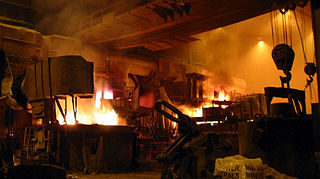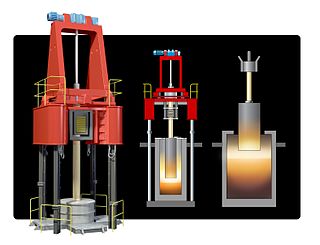
Steelmaking is the process for producing steel from iron ore and scrap. In steelmaking, impurities such as nitrogen, silicon, phosphorus, sulfur and excess carbon are removed from the sourced iron, and alloying elements such as manganese, nickel, chromium and vanadium are added to produce different grades of steel. Limiting dissolved gases such as nitrogen and oxygen, and entrained impurities in the steel is also important to ensure the quality of the products cast from the liquid steel.

A blast furnace is a type of metallurgical furnace used for smelting to produce industrial metals, generally pig iron, but also others such as lead or copper. Blast refers to the combustion air being "forced" or supplied above atmospheric pressure.

In petrochemistry, petroleum geology and organic chemistry, cracking is the process whereby complex organic molecules such as kerogens or long-chain hydrocarbons are broken down into simpler molecules such as light hydrocarbons, by the breaking of carbon-carbon bonds in the precursors. The rate of cracking and the end products are strongly dependent on the temperature and presence of catalysts. Cracking is the breakdown of a large alkane into smaller, more useful alkenes. Simply put, hydrocarbon cracking is the process of breaking a long-chain of hydrocarbons into short ones. This process requires high temperatures and high pressure.

Basic oxygen steelmaking, also known as Linz–Donawitz-steelmaking or the oxygen converter process is a method of primary steelmaking in which carbon-rich molten pig iron is made into steel. Blowing oxygen through molten pig iron lowers the carbon content of the alloy and changes it into low-carbon steel. The process is known as basic because fluxes of burnt lime or dolomite, which are chemical bases, are added to promote the removal of impurities and protect the lining of the converter.

The cementation process is an obsolete technology for making steel by carburization of iron. Unlike modern steelmaking, it increased the amount of carbon in the iron. It was apparently developed before the 17th century. Derwentcote Steel Furnace, built in 1720, is the earliest surviving example of a cementation furnace. Another example in the UK is the cementation furnace in Doncaster Street, Sheffield.

Henry Cort was an English ironmaster. During the Industrial Revolution in England, Cort began refining iron from pig iron to wrought iron using innovative production systems. In 1783-1784 he patented the puddling process for refining cast iron although its commercial viability was only accomplished by innovations introduced by the Merthyr Tydfil ironmasters Crawshay and Homfray.

A heating element converts electrical energy into heat through the process of Joule heating. Electric current passing through the element encounters resistance, resulting in heating of the element. Unlike the Peltier effect, this process is independent of the direction of current flow.
Pyrometallurgy is a branch of extractive metallurgy. It consists of the thermal treatment of minerals and metallurgical ores and concentrates to bring about physical and chemical transformations in the materials to enable recovery of valuable metals. Pyrometallurgical treatment may produce products able to be sold such as pure metals, or intermediate compounds or alloys, suitable as feed for further processing. Examples of elements extracted by pyrometallurgical processes include the oxides of less reactive elements like iron, copper, zinc, chromium, tin, and manganese.

Puddling was one step in one of the most important processes of making the first appreciable volumes of high-grade bar iron during the Industrial Revolution. In the original puddling technique, molten iron in a reverberatory furnace was stirred with rods, which were consumed in the process. It was one of the first processes for making bar iron without charcoal in Europe, although much earlier coal-based processes had existed in China. Eventually, the furnace would be used to make small quantities of specialty steels.

A foundry is a factory that produces metal castings. Metals are cast into shapes by melting them into a liquid, pouring the metal into a mold, and removing the mold material after the metal has solidified as it cools. The most common metals processed are aluminium and cast iron. However, other metals, such as bronze, brass, steel, magnesium, and zinc, are also used to produce castings in foundries. In this process, parts of desired shapes and sizes can be formed.

Electroslag remelting (ESR), also known as electro-flux remelting, is a process of remelting and refining steel and other alloys for mission-critical applications in aircraft, thermal power stations, nuclear power plants, military technology, et al.

Hot blast refers to the preheating of air blown into a blast furnace or other metallurgical process. As this considerably reduced the fuel consumed, hot blast was one of the most important technologies developed during the Industrial Revolution.
Hot blast also allowed higher furnace temperatures, which increased the capacity of furnaces.
Vacuum induction melting (VIM) utilizes electric currents to melt metal within a vacuum. The first prototype was developed in 1920. One of the only ways to induce a current within a conductor is through electromagnetic induction. Electromagnetic induction induces eddy currents within conductors by changing the magnetic field. Eddy currents create heating effects to melt the metal. Vacuum induction melting has been used in both the aerospace and nuclear industries.
In metallurgy, refining consists of purifying an impure metal. It is to be distinguished from other processes such as smelting and calcining in that those two involve a chemical change to the raw material, whereas in refining, the final material is usually identical chemically to the original one, only it is purer. The processes used are of many types, including pyrometallurgical and hydrometallurgical techniques.
The Ames process is a process by which pure uranium metal is obtained. It can be achieved by mixing any of the uranium halides with magnesium metal powder or aluminium metal powder.
The Electric Smelting and Aluminum Company, founded as Cowles Electric Smelting and Aluminum Company, and Cowles Syndicate Company, Limited, formed in the United States and England during the mid-1880s to extract and supply valuable metals. Founded by two brothers from Ohio, the Cowles companies are remembered for producing alloys in quantity sufficient for commerce. Their furnaces were electric arc smelters, one of the first viable methods for extracting metals.
Meredith Wooldridge Thring, FREng, FIMechE, FIET, FInstP, FIChemE, FEI was a British inventor, engineer, futurologist, professor and author.

William T. Kane was a physicist for Corning Incorporated, formerly Corning Glass Works, Inc., in Corning, New York, who held patents in crystallography and heat-sensing technology—developments which contributed to the early processing and manufacture of fiber optics. He was also the Corning representative for the establishment of international standards in the use of fiber optics in communications.
Electrona is a small residential area on the d'Entrecasteaux Channel in Southern Tasmania. It grew up around the Electrona Carbide Works which were established in 1909.



















